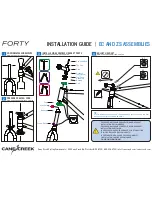
Original User Manual | Pedelec Impulse 2.0 Ergo
5
If you wish to make any adjustments to the ride char-
acteristics of your Pedelec, please consult your spe-
cialist cycle shop.
1.2 Statutory requirements
The Pedelec, like all other bikes, must comply with
the national regulations for road safety. Please ob-
serve the relevant explanations and general informa-
tion provided in the General User Manual (CD).
These statutory requirements apply for a Pedelec:
•
The motor is designed only to provide pedal-
ling assistance, i.e. it can only “assist” the rider
when he/she turns the pedals.
•
The average motor output must not exceed
250 W.
•
As the speed increases, the rate at which the
motor output reduces must also increase more
intensely.
•
The motor must switch off once the bike reaches
a speed of 25 km/h.
1.2.1 Requirements for the rider
›
You do not legally have to wear a helmet. Howev-
er, in the interest of your own safety, you should
never ride without a helmet.
›
You do not legally have to have a driving licence.
›
You do not legally have to have insurance.
›
No age restriction applies for a Pedelec.
›
The regulations governing the use of cycle paths
are the same as for normal bikes.
These regulations apply to you wherever you are in
the European Union. It is possible that different regu-
lations exist in other countries, also inside the EU in
individual cases. Before using your Pedelec abroad,
find out about the applicable legislation in the rel-
evant country.
1.3 Battery
›
Never attempt to repair your battery. Specialists
are responsible for performing such repairs. If
your battery is damaged, contact your specialist
cycle shop. The specialists here will discuss the
next steps with you.
›
Never transport damaged batteries. The safety
of damaged batteries cannot be guaranteed.
Scratches and small chips in the housing do not
constitute serious damage.
›
Have the battery checked at a specialist cycle
shop if you have fallen off your Pedelec. You
must also consult your specialist cycle shop
if the battery has fallen or fallen off. Damaged
batteries must neither be charged nor used for
another application.
›
During the charging process, the battery and
charger must be placed on a flat, non-flammable
surface. The battery and charger must not be
covered to ensure that the hot air produced dur-
ing the charging process does not accumulate
and lead to overheating or even a fire. There
must be no highly combustible materials in the
immediate vicinity. This also applies when charg-
ing the battery on the Pedelec. In this case, you
must place the Pedelec so as to prevent any fire
from spreading quickly (exercise caution with
carpeted floors!).
›
Lithium reacts very strongly upon direct contact
with water. Caution is therefore required in the
case of damaged batteries which have become
wet, as they may catch fire.
›
Water should be used to extinguish any flames in
the immediate vicinity, but not the battery itself.
Extinguishers with metal fire powder (Class D)
are better suited to this task. If the battery can
be safely moved outdoors, the fire can also be
suffocated using sand.






































